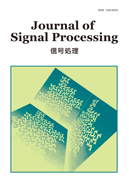
- Issue 6 Pages 229-
- Issue 5 Pages 207-
- Issue 4 Pages 133-
- Issue 3 Pages 81-
- Issue 2 Pages 41-
- Issue 1 Pages 1-
- |<
- <
- 1
- >
- >|
-
Md. Saifur Rahman, Yosuke Sugiura, Tetsuya Shimamura2020Volume 24Issue 5 Pages 207-222
Published: September 10, 2020
Released on J-STAGE: September 10, 2020
JOURNAL FREE ACCESSIn this paper, we present the use of the fourth-root spectrum instead of the log spectrum for pitch extraction in noisy environments. To obtain clear harmonics, lifter and clipping operations are performed. When the resulting spectrum is transformed into the time domain by the discrete Fourier transform, pitch detection is robust against narrow-band noise. When the same spectrum is amplified by power calculation and transformed into the time domain, pitch detection is robust against wide-band noise. These properties are investigated through exhaustive experiments in various noises. The required computational time is also studied.
View full abstractDownload PDF (3643K) -
21. Why Can We Apply Circuit Theory to Physical Wave Phenomenon ?Nobuo Nagai, Takashi Yahagi2020Volume 24Issue 5 Pages 223-228
Published: September 10, 2020
Released on J-STAGE: September 10, 2020
JOURNAL FREE ACCESSIn this lecture series, we attempt to construct a theoretical system of quantum theory that emphasizes the wave nature (in other words, that is based on circuit theory) and assumes quanta to be circuit elements. Circuit equations given by voltage and current have steady-state and transient responses. The steady-state response is expressed by complex numbers. For lossless circuits, the active and reactive powers can be distinguished, and the active power is expressed by a conserved quantity. In physics, physical phenomena are considered to occur as a result of some motion, suggesting the importance of motion. In circuit theory, a transient response is generated when a steady state transits to another steady state. In the transient response, the active and reactive powers cannot be distinguished. Therefore, the transient response is considered to be a physical phenomenon without a conserved quantity and to require special techniques involving difficult problems, such as renormalization.
View full abstractDownload PDF (415K)
- |<
- <
- 1
- >
- >|